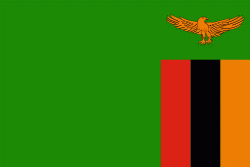Kafue
Kafue is a town in the Lusaka Province of Zambia and it lies on the north bank of the Kafue River, after which it is named. It is the southern gateway to the central Zambian plateau on which Lusaka and the mining towns of Kabwe and the Copperbelt are located. It is located on the T2 Road (Great North Road).
Kafue is at the south-eastern foot of a range of granite hills rising 200 m and extending over an area of about 250 km², and occupies a shelf of land between the hills and the river, just high enough to avoid its annual flood. The town extends along some shallow valleys between the hills. A 400 m wide strip of small farms and gardens separates the town from a bend of the river which is about 300 m wide in the dry season and 1.3 km wide in the rainy season, sometimes inundating a floodplain 10 km wide on the opposite bank, which consequently is uninhabited save for a few small villages or farms on higher ground.
Kafue is at the south-eastern foot of a range of granite hills rising 200 m and extending over an area of about 250 km², and occupies a shelf of land between the hills and the river, just high enough to avoid its annual flood. The town extends along some shallow valleys between the hills. A 400 m wide strip of small farms and gardens separates the town from a bend of the river which is about 300 m wide in the dry season and 1.3 km wide in the rainy season, sometimes inundating a floodplain 10 km wide on the opposite bank, which consequently is uninhabited save for a few small villages or farms on higher ground.
Map - Kafue
Map
Country - Zambia
 |
 |
| Flag of Zambia | |
The region was affected by the Bantu expansion of the 13th century. Following the arrival of European explorers in the 18th century, the British colonised the region into the British protectorates of Barotseland-North-Western Rhodesia and North-Eastern Rhodesia comprising 73 tribes, towards the end of the 19th century. These were merged in 1911 to form Northern Rhodesia. For most of the colonial period, Zambia was governed by an administration appointed from London with the advice of the British South Africa Company. On 24 October 1964, Zambia became independent of the United Kingdom and prime minister Kenneth Kaunda became the inaugural president. From 1972 to 1991 Zambia was a one-party state with the United National Independence Party as the sole legal political party under the motto "One Zambia, One Nation" coined by Kaunda. Kaunda was succeeded by Frederick Chiluba of the social-democratic Movement for Multi-Party Democracy in 1991, beginning a period of government decentralisation.
Currency / Language
| ISO | Currency | Symbol | Significant figures |
|---|---|---|---|
| ZMW | Zambian kwacha | ZK | 2 |
| ISO | Language |
|---|---|
| NY | Chichewa language |
| EN | English language |















